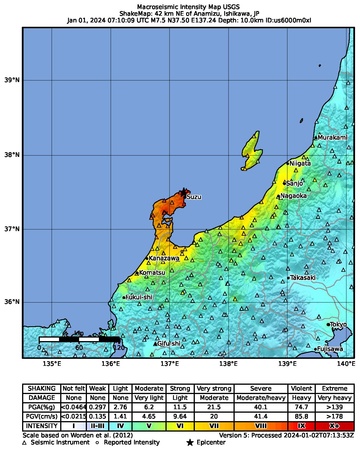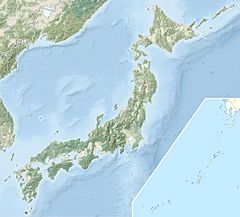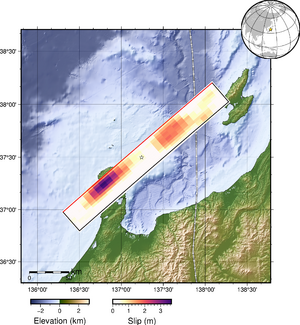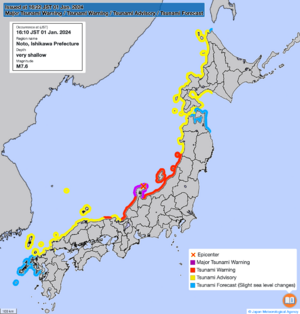2024 Sea of Japan earthquake facts for kids
| 令和6年能登半島地震 | |
 |
|
| UTC time | 2024-01-01 07:10:09 |
|---|---|
| ISC event | 636373819 |
| USGS-ANSS | ComCat |
| Local date | 1 January 2024 |
| Local time | 16:10:09 JST (UTC+9) |
| Duration | c. 40 seconds |
| Magnitude | 7.6 MJMA 7.5 Mw |
| Depth | 10 km (6 mi) (USGS) |
| Epicenter | 37°29′53″N 137°14′31″E / 37.498°N 137.242°E |
| Type | Reverse |
| Areas affected | Japan |
| Max. intensity |
|
| Tsunami | 1.2 m (3.9 ft) |
| Landslides | Yes |
| Foreshocks | 5.7 MJMA |
| Aftershocks | ≥60, largest being 6.1 MJMA |
| Casualties | 48 dead, 109 injured, 2 cardiac arrests |
On January 1, 2024, a strong earthquake hit the Noto Peninsula in Ishikawa Prefecture, Japan. It happened at 4:10 PM JST. The earthquake had a magnitude of 7.6 (Japan Meteorological Agency) or 7.5 (USGS). Its center was about 7 kilometers (4 miles) north-northwest of Suzu.
This earthquake was the biggest in Japan since 2015. The Japan Meteorological Agency (JMA) officially named it the 2024 Noto Peninsula Earthquake. It also caused Japan's first major tsunami warning since the 2011 Tōhoku earthquake. A tsunami wave over 1.2 meters (4 feet) high was seen along the Sea of Japan coast.
Contents
Understanding Earthquakes
Japan sits where several large tectonic plates meet. These plates are like huge pieces of the Earth's crust. They are always moving slowly. Along Japan's west coast, the Amurian and Okhotsk Plates push against each other. This pushing can cause stress to build up. When this stress is released suddenly, it causes an earthquake.
The Noto Peninsula area has had many smaller earthquakes for three years. This 2024 earthquake was the strongest one in this group. It was also the strongest earthquake to hit the Sea of Japan region since 1983.
The Main Earthquake
The United States Geological Survey (USGS) said the earthquake had a magnitude of 7.5. It happened about 10 kilometers (6 miles) deep. The Japan Meteorological Agency (JMA) measured it as a magnitude 7.6. This earthquake happened along a "reverse fault." This means one block of rock moved up and over another block.
Just four minutes before the main earthquake, a smaller earthquake (magnitude 5.5) happened. This is called a foreshock. Nine minutes after the main earthquake, a magnitude 6.2 earthquake struck. This was an aftershock. About 60 aftershocks were recorded in total. At least seven of them were magnitude 5.0 or higher.
Scientists found that the earthquake's break in the Earth's crust was very long. It stretched about 200 kilometers (124 miles) from the Noto Peninsula to Sado Island. In some places, the ground moved as much as 3.67 meters (12 feet). The Geospatial Information Authority of Japan reported that parts of the country moved up to 1.3 meters (4.3 feet) to the west. This was due to the ground shifting.
How Strong it Felt (Intensity)
The JMA uses a special scale to measure how strong an earthquake feels. It's called the Shindo scale. The highest level is Shindo 7. This earthquake reached Shindo 7 in Shika, Ishikawa Prefecture. This was the first time an earthquake of this strength was felt in Japan since 2018.
Other areas felt very strong shaking too. Shindo 6+ was recorded in Nanao, Wajima, Suzu, and Anamizu. People in Tokyo and other parts of Japan also felt the earthquake.
Tsunami Waves
After the earthquake, large parts of Japan's western coast received tsunami warnings. These warnings stretched from Hokkaido to Nagasaki Prefecture. People in Ishikawa, Niigata, Toyama, and Yamagata prefectures were told to evacuate. Public broadcaster NHK warned that waves up to 5 meters (16 feet) could be expected. However, the actual waves that arrived were smaller.
The first tsunami waves hit around 4:21 PM. Waves over 1.2 meters (4 feet) struck Wajima. A 90-centimeter (3-foot) tsunami hit Kanazawa. Waves of 80 centimeters (2.6 feet) hit Toyama Prefecture and Sakata. Smaller waves were recorded in many other coastal towns.
In Suzu, the tsunami washed homes off their foundations. Some houses were carried further inland. Many fishing boats were flipped over or pushed onto land. A resident saw waves washing over a road, picking up cars and debris. The governor of Ishikawa Prefecture said the tsunami flooded the Iida Port area up to 100 meters (328 feet) inland.
The major tsunami warning was lowered to a regular tsunami warning about four hours after the earthquake. All tsunami warnings were lifted about 18 hours after the earthquake.
Tsunami in Other Countries
Other countries along the Sea of Japan also saw tsunami waves.
- South Korea: Waves up to 0.85 meters (2.8 feet) hit Mukho. Smaller waves were recorded in other coastal cities.
- Russia: Warnings for waves up to 1 meter (3.3 feet) were issued for the west coast of Sakhalin Island. However, officials later said the tsunami passed almost unnoticed in some areas like Vladivostok and Nakhodka.
Impact and Damage
The earthquake caused significant damage, especially in Ishikawa Prefecture.
- Casualties: 48 people died, mostly due to houses collapsing. 109 people were injured across seven prefectures.
- Building Collapse: In Wajima, at least 50 houses collapsed. Many homes also collapsed in Suzu.
- Fires: A large fire started in Wajima around 5:00 PM. Damaged roads made it hard for firefighters to reach the area. The fire destroyed about 200 buildings, including many homes.
- Landslides: Many landslides happened across the mountainous parts of the Noto Peninsula. One landslide ripped apart a main expressway between Toyama and Kanazawa.
- Infrastructure Damage:
- Noto Airport was closed because of five cracks, each up to 10 meters (33 feet) long, on its runway. The airport terminal was also damaged.
- Roads were cracked, and water pipes broke in cities like Himi and Oyabe.
- In Niigata city, the ground became like liquid (called liquefaction). Sewer pipes broke, and many homes lost water.
- Telecommunication companies reported phone and internet outages in Ishikawa and Niigata.
- Power Outages: About 36,000 homes lost electricity.
- Nuclear Power Plants: The Shika Nuclear Power Plant had an explosion near a power transformer at one reactor. Another transformer was damaged by an oil spill. However, there were no reports of radiation leaks.
Global Support
Leaders from other countries sent their good wishes to Japan. These included the presidents of Taiwan, the Philippines, and the United States, and the Prime Minister of the United Kingdom. They offered to send help to Japan if needed.
|
See also
 In Spanish: Terremoto de la península de Noto de 2024 para niños
In Spanish: Terremoto de la península de Noto de 2024 para niños




